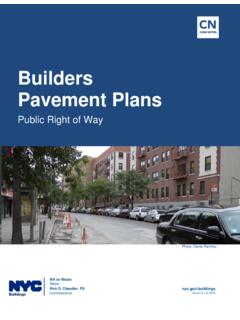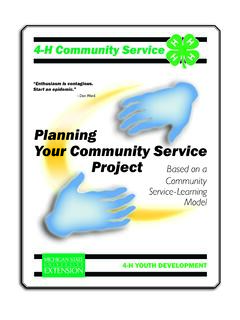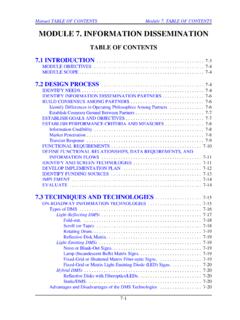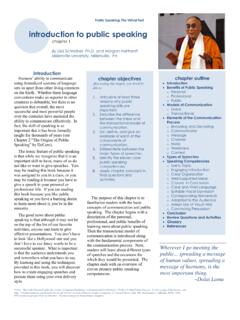Transcription of A Guide to Riverfront Development - Riverlife
1 1A Guide to Riverfront DevelopmentA Guide to Riverfront DevelopmentConnecting communities to the water2 RiverlifeFunding For this document was made possible by the claude worthington benedum Foundation1A Guide to Riverfront DevelopmentIntroduction Natural River Edges Connections To the River Along the River Landings Districts Built Buildings Stormwater Character Landscape Public Art Lighting2 6 1015 20 21 2428 3237 40 Table of Contents2 Riverlife3A Guide to Riverfront DevelopmentSo went the common advice given to Pittsburgh children by their parents for nearly a century as they ventured out to play on warm summer afternoons.
2 The warning is telling in a number of ways, offering a glimpse into the hostile conditions along Pittsburgh s urban riverfronts prior to 1990 and the public attitudes surrounding them. People living in the Pittsburgh region prior to the city s modern renaissance had good reason for concern. For generations the downtown riverfronts were largely invisible, cut off from neighborhoods by industrial yards, rail tracks and highways that took advantage of the riverfronts miles of flatness but created a tangle of barriers. If one was lucky enough to forge a path through scrap yards and private property to get to the water s edge, what awaited was less than appealing: Pittsburgh s three rivers had been polluted and eroded after years of industrial use with invasive weeds choking out the natural landscape.
3 Very few opportunities for Riverfront recreation and relaxation existed. Be home before dark and stay away from the rivers. And yet, people were drawn to the rivers. They never gave up their dreams for the riverfronts, for swimming and cycling and picnicking along the waters of the Allegheny, Monongahela and Ohio. And so, use and interaction with the rivers of Southwestern Pennsylvania has been changing over the years as Pittsburgh recovered from the collapse of the steel industry in the 1980s and sought to reinvent itself through its natural assets. Formerly viewed as the backdoor to the city, Pittsburgh s riverfronts are now embraced as the shining face of a new city, dotted with parks, residences, businesses, and industries that have brought over $4 billion of adjacent Development to the city since inspired such a dramatic shift?
4 As Riverfront land became available for Development and recreation, a priority was given to considering the wants and needs of the community. As the new front yard for the community, riverfronts must now accommodate the routines of runners, strollers, anglers, boaters, and working barges, among other users. Successful Riverfront Development doesn t have to start on a grand scale. Sometimes the smallest projects are the most potent. A small park, boat launch, stormwater landscape or fishing pier, created at the right time and embraced by the community, can have a catalytic effect and lead to bigger things down the road.
5 A building with windows, pathways and terraces that connect to and celebrate the Riverfront is a source of pleasure and pride, indoors and 1999, Riverlife has worked to reclaim, restore and promote Pittsburgh s urban riverfronts. Formerly known as Riverlife Task Force, Riverlife was formed to conduct hundreds of public meetings, convene property owners, public officials and civic stakeholders and facilitate the creation of a master plan for developing Pittsburgh s downtown riverfronts. Ever since then, Riverlife has been thinking about strategies to reconnect people to the rivers.
6 Pittsburgh can now point to dozens of projects of varying scale to demonstrate that reclaiming the Riverfront advances economic Development , transforms the environment and opens up recreational opportunities. We ve learned valuable lessons and have created guidelines based on best practices for designing and developing riverfronts of all sizes. Here we have collected these resources for easy access and application across Southwestern Pennsylvania to launch conversations about the opportunities for improvements in the many river communities throughout the region. We hope this document will serve as a useful resource for property owners, planners, developers, public agencies, and nonprofit organizations who want to seize moments of opportunity and maximize the potential of their Riverfront assets.
7 This document is not intended to replace a community s existing zoning code, district plans, or ordinances, but rather establish optimal planning goals and to aid in enhancing and coordinating Riverfront projects, large and small. More detailed information can be found in the original documents, and the best results are often reached through consultation with professional new investment along the rivers encourages activity, unleashes vitality and increases land value, while providing places for people to Guide to Riverfront DevelopmentriverliFe resource documentsThis information was compiled from seven resources that Riverlife has produced in the past.
8 These resources, listed below, offer additional details on each aspect of Riverfront Development . An online version of this information also provides useful links and information: A Vision Plan for Pittsburgh s Riverfronts Three Rivers Park Design GuidelinesConnecting the Loop PlanThree Rivers Park Lighting StrategyLandscape Management Guidelines Three Rivers Park Public Art StrategyStormwater Is the CommunicatorPRINCIPles foR Riverfront DeveloPmeNTWhen planning a Riverfront Development , let these core principles lead the thinking: Feature the Riverfront as the front door.
9 Showcase the river s history. Activate the Riverfront . Limit obstacles and connect to the river. Engage with the water. Connect seamlessly along the Riverfront and into neighborhoods. Repair and enhance the environment. Employ high-quality architectural materials and sustainable engineering on to learn essential aspects of Riverfront , shorelines, riparian buffers, and river habitat are critically important when planning any Riverfront project. 7A Guide to Riverfront DevelopmentdeFinitionsriparian bufferA permanent naturally vegetated area located adjacent to a stream, river, lake, pond or with the form of living organisms, and with relationships between their the occurrence, distribution, movement, and properties of the waters of the earth and their relationship with the environment within each phase of the hydrologic or water system of cultivation intended to maintain permanent agriculture or horticulture by relying on renewable resources and a self-sustaining , shorelines, riparian buffers.
10 And river habitats are critically important when planning any Riverfront project. Other important components of ecosystem function that should be considered include geology, morphology, hydrology, and land cover. Along the river, there are many opportunities for integrated regenerative design, stormwater management, habitat restoration, public access, stewardship, and redevelopment. Key ConceptsBuFFER TyPOLOgy 1 Dense Urban Development Buffer Zone In a dense urban Development , a buffer zone should include design and Development techniques that will provide and enhance the following.







